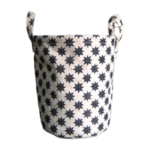Fabric Weight Chart
GSM (grams per square meter) is a measure of fabric weight. To calculate it, measure the weight of a fabric piece that is one square meter in area—that weight is the GSM. For example, if a one square meter piece weighs 220 grams, the fabric is 220 GSM.
Oz/yd² (ounces per square yard) is the imperial equivalent of GSM, commonly used for measuring canvas. In everyday language, people often refer to fabric simply by its ounce measurement, such as a 10 oz fabric (10 oz/yd²). To convert between GSM and oz/yd²: 1 oz/yd² equals 33.9 GSM.
In the fabric trade, g/m (grams per meter) is a more specialized term. To convert GSM to g/m, multiply the GSM by the fabric's width. For example, a 100 GSM fabric with a width of 1.5 meters would be 150 g/m.
GSM to OZ Conversion Table
| gsm (g/m²) | oz/yd² | g/m (gram per meter) (Based on fabric width: 1.5meter wide per meter running length) |
|---|---|---|
| 50 | 1.47 | 75 |
| 60 | 1.77 | 90 |
| 70 | 2.06 | 105 |
| 80 | 2.36 | 120 |
| 90 | 2.65 | 135 |
| 100 | 2.95 | 150 |
| 110 | 3.24 | 165 |
| 120 | 3.54 |
180 |
|
130 |
3.83 | 195 |
|
140 |
4.13 |
210 |
|
150 |
4.42 |
210 |
|
160 |
4.72 |
240 |
|
170 |
5.01 |
255 |
|
180 |
5.31 |
270 |
|
190 |
5.6 |
285 |
|
200 |
5.9 |
300 |
|
210 |
6.19 |
315 |
|
220 |
6.49 |
330 |
|
230 |
6.78 |
345 |
|
240 |
7.08 |
360 |
|
250 |
7.37 |
375 |
|
260 |
7.67 |
290 |
|
270 |
7.96 |
405 |
|
280 |
8.26 |
420 |
|
290 |
8.55 |
435 |
|
300 |
8.85 |
450 |
|
310 |
9.14 |
465 |
|
320 |
9.44 |
480 |
|
330 |
9.73 |
495 |
|
340 |
10.03 |
510 |
|
350 |
10.32 |
525 |
|
360 |
10.62 |
540 |
|
370 |
10.91 |
555 |
|
380 |
11.21 |
570 |
|
390 |
11.5 |
585 |
|
400 |
11.8 |
600 |
|
410 |
12.09 |
615 |
OZ/YD2 to GM to GSM
Weight Chart for Cotton Canvas Fabric
| Cotton Canvas | Popular Name | Features |
|---|---|---|
| 2 oz | Cotton | extremely thin. Can be used for newspaper sacks etc. |
| 4 oz | Cotton | Although it is a thin material, it is the most widely used to make inexpensive cotton bags. |
| 6 oz | Cotton | 6 oz and 4 oz are harder to separate apart. Therefore, occasionally it makes sense to choose a 4-ounce cheaper material. |
| 8 oz | Canvas | Less commonly used than 10oz canvas for making bags. |
| 10 oz | Canvas | Highly popular for crafting premium Canvas Tote Bags, this canvas is built to last for years and improves in appearance after a few washes. |
| 12 oz | Canvas | Stronger than 10oz, it's ideal for creating more refined and polished Canvas bags. |
| 14 oz | Canvas | A top choice for fashion tote bags. |
| 16 oz | Canvas | A top choice for fashion tote bags. |
| 18 oz | Canvas | A top choice for fashion tote bags. |
Weight Chart for Jute Fabric
| Fabric Mesh / Strands | Description | Uses |
|---|---|---|
| 11/12 | More effective for gardening or packaging. | |
| 12/13 | Suitable for gardening or packing purposes. | |
| 13/13 (12oz) | 13 strands by 13 strands in one inch | This is the most used jute fabric for crafting lightweight tote bags. |
| 13/14 | Not as commonly used for making tote bags. | |
| 14/15 (16oz) | 14 strands by 15 strands in one inch | Premium fabric for stylish and durable fashion bags. |
| 15/16 | Not as commonly used for making tote bags. | |
| 17/17 (20oz) | 17 strands by 17 strands in one inch | More suitable for fashion tote bags due to its refined appearance. |
| 16 oz | ||
| 18 oz |
| gsm (g/m²) | oz/yd² | g/m (gram per meter) (Based on fabric width: 1.5meter wide per meter running length) |
|---|---|---|
| 50 | 1.47 | 75 |
| 60 | 1.77 | 90 |
| 70 | 2.06 | 105 |
| 80 | 2.36 | 120 |
| 90 | 2.65 | 135 |
| 100 | 2.95 | 150 |
| 110 | 3.24 | 165 |
| 120 | 3.54 |
180 |
|
130 |
3.83 | 195 |
|
140 |
4.13 |
210 |
|
150 |
4.42 |
210 |
|
160 |
4.72 |
240 |
|
170 |
5.01 |
255 |
|
180 |
5.31 |
270 |
|
190 |
5.6 |
285 |
|
200 |
5.9 |
300 |
|
210 |
6.19 |
315 |
|
220 |
6.49 |
330 |
|
230 |
6.78 |
345 |
|
240 |
7.08 |
360 |
|
250 |
7.37 |
375 |
|
260 |
7.67 |
290 |
|
270 |
7.96 |
405 |
|
280 |
8.26 |
420 |
|
290 |
8.55 |
435 |
|
300 |
8.85 |
450 |
|
310 |
9.14 |
465 |
|
320 |
9.44 |
480 |
|
330 |
9.73 |
495 |
|
340 |
10.03 |
510 |
|
350 |
10.32 |
525 |
|
360 |
10.62 |
540 |
|
370 |
10.91 |
555 |
|
380 |
11.21 |
570 |
|
390 |
11.5 |
585 |
|
400 |
11.8 |
600 |
|
410 |
12.09 |
615 |
OZ/YD2 to GM to GSM
| Cotton Canvas | Popular Name | Features |
|---|---|---|
| 2 oz | Cotton | extremely thin. Can be used for newspaper sacks etc. |
| 4 oz | Cotton | Although it is a thin material, it is the most widely used to make inexpensive cotton bags. |
| 6 oz | Cotton | 6 oz and 4 oz are harder to separate apart. Therefore, occasionally it makes sense to choose a 4-ounce cheaper material. |
| 8 oz | Canvas | Less commonly used than 10oz canvas for making bags. |
| 10 oz | Canvas | Highly popular for crafting premium Canvas Tote Bags, this canvas is built to last for years and improves in appearance after a few washes. |
| 12 oz | Canvas | Stronger than 10oz, it's ideal for creating more refined and polished Canvas bags. |
| 14 oz | Canvas | A top choice for fashion tote bags. |
| 16 oz | Canvas | A top choice for fashion tote bags. |
| 18 oz | Canvas | A top choice for fashion tote bags. |
| Fabric Mesh / Strands | Description | Uses |
|---|---|---|
| 11/12 | More effective for gardening or packaging. | |
| 12/13 | Suitable for gardening or packing purposes. | |
| 13/13 (12oz) | 13 strands by 13 strands in one inch | This is the most used jute fabric for crafting lightweight tote bags. |
| 13/14 | Not as commonly used for making tote bags. | |
| 14/15 (16oz) | 14 strands by 15 strands in one inch | Premium fabric for stylish and durable fashion bags. |
| 15/16 | Not as commonly used for making tote bags. | |
| 17/17 (20oz) | 17 strands by 17 strands in one inch | More suitable for fashion tote bags due to its refined appearance. |
| 16 oz | ||
| 18 oz |
At Eco Jute Bags, we exclusively use 14/15 jute fabric for our grocery, shopping, and promotional bags. This premium-grade jute ensures superior durability and an aesthetically pleasing finish. While 13/13 fabric may be more affordable, it’s too thin to maintain its shape after repeated use. Additionally, 14/15 jute offers a much better canvas for screen printing, resulting in sharper, more vibrant designs.
Fabric Weight Chart for Non-Woven Fabric
Non-woven fabric is a petroleum-based product that, like plastic, does not decompose in landfills, making it far from environmentally friendly. Despite being reusable, non-woven bags are often mistakenly categorized as eco-friendly. At Eco Jute Bags, we do not support the use of non-woven fibers due to their lack of fashion appeal and negative environmental impact. Many countries have already taken steps to ban or discourage the use of non-woven materials.
The main advantage of non-woven fiber is its affordability, and since it’s derived from plastic, it offers some water resistance. Non-woven fabric ranges from 10 GSM to 150 GSM, with 70-120 GSM being the most common weights. Most grocery bags sold in stores are made from 70-80 GSM material.
At Eco Jute Bags, we exclusively use non-woven fabric for cooler bags and insulated bags designed for frozen foods. For all other applications, we have phased out non-woven bags in favor of more sustainable options.





